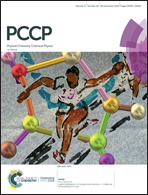Carbon monoxide activation by atomic thorium: ground and excited state reaction pathways†
Abstract
Multi-reference configuration interaction (MRCI) and single reference coupled cluster calculations are performed for the ThCO and OThC isomers. Scalar and spin–orbit relativistic effects are considered through a relativistic pseudopotential and the coupling of MRCI wavefunctions via the Breit–Pauli spin–orbit Hamiltonian. Optimized geometries, excitation energies, and vibrational frequencies are reported for both isomers. Full potential energy profiles are constructed for the Th+CO reaction and the conversion of the produced ThCO to OThC. Linear ThCO was found to be more stable than the highly ionic bent OThC system by about 4 kcal mol−1. The interconversion barrier is estimated to be around 30 kcal mol−1. Our results are in agreement with earlier experimental data for the two isomers. The lowest lying states of Th do not populate f-orbitals and resemble the electronic structure of Ti. Therefore, the ability of the two atoms to activate the C![[triple bond, length as m-dash]](https://www.rsc.org/images/entities/char_e002.gif) O bond is compared. OTiC is found to be about 40 kcal mol−1 less stable than TiCO revealing the efficiency of Th and possibly other f-block elements to activate multiple chemical bonds as opposed to d-block metals.
O bond is compared. OTiC is found to be about 40 kcal mol−1 less stable than TiCO revealing the efficiency of Th and possibly other f-block elements to activate multiple chemical bonds as opposed to d-block metals.

- This article is part of the themed collection: 2019 PCCP HOT Articles


 Please wait while we load your content...
Please wait while we load your content...